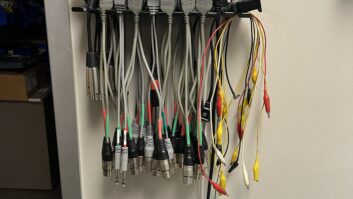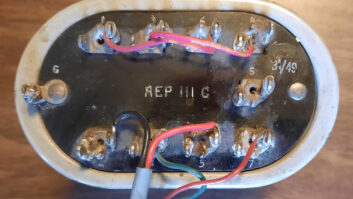Bob Gonsett’s CGC Communicator newsletter had an interesting item recently, about an electric mattress pad that generates radio frequency interference, or RFI. The interference destroys reception of Channels 2 through 6, as well as stations operating in the FM broadcast band.
The engineers from Communications General Corp. found the problem is caused by an inadequately shielded switching-type AC-to-DC power supply.
Even when the mattress pad is turned off, RFI bursts are still generated if the power supply is plugged into an outlet. The home or apartment wiring serves as an antenna, making the problem worse. The interference sounds like a “tic-tic-tic” and consists of brief wideband pulses with a one-second delay between the pulses. Under the right conditions, CGC found that the interference can extend up to 250 from the source.
The pad and power supply are manufactured by Perfect Fit Industries, and the product is not FCC Part 15-compliant. CGC found no Part 15 sticker on the system it inspected. To make matters worse, when both Perfect Fit and the power supply design engineer were questioned by CGC, they were unfamiliar with the FCC’s Part 15 requirements that prohibit the marketing of RFI generating devices.
You can see a picture of the pad system as sold by a retailer at www.assistedlivingstore.com/lv_electric_blanket.asp
The product is also sold by Kmart, so a wide distribution can be expected. Perfect Fit has indicated that they have pages of RFI complaints and are acting promptly to develop a Part 15 compliant power supply. CGC stumbled upon one such complaint at www.eham.net/forums/RFI/161.
This entire case has been turned over to the FCC, and the NAB has been notified. If your station maintains an engineering page on its Web site, this is one link you may want to include. It might save you some time in tracking down an RFI problem, and inform your listeners of a potential problem at the same time!
. . .
Scott Todd of Minnesota AM stations KKMS and WWTC would like to see more written about servicing boards with surface mount devices, or SMDs. I imagine the reason there hasn’t been is that without the proper tools, this kind of repair is pretty rough to do in the field.
Scott had to repair a couple of distribution amps damaged last summer from a big lightning strike. He fixed the first one without too much trouble, but the second amplifier was another story. Scott ended up lifting a couple foils in the process of changing out the SMD.
From his experience, he learned that it’s best to clip the leads off the chip and then remove the leads. The glue holding the surface mount device can be a problem, too. Even though Scott would like to appeal for broadcast equipment to not be made with SMDs, the cost and space savings for manufacturers make this unlikely.
We’d appreciate hearing from readers who have tips on repairing boards using SMDs, especially if you’ve found a way using regular shop tools. Write to us at [email protected]. Scott Todd is at [email protected]
(click thumbnail)
Scott also wrote that he had a difficult time finding companies that stock SMD parts.
Sourcing small parts can be a problem, especially if you’re not in a major city. George Pfisterer Jr. of Pfisterer Sound Engineering sent in names of more online sources for small electronic parts, in addition to the ones we’ve mentioned here in the past. Bookmark the ones shown in Fig. 1.
George can be reached at [email protected].

. . .
While on the subject of parts, here’s a great resources from the folks at Telos Systems. This tip comes from the company’s weekly e-newsletter.
If you rebuild old gear, you’ve undoubtedly run up against obsolete transistors that need replacing. The University of Washington has compiled a fast, easy-to-use online cross-reference. You simply enter the ID of the old transistor, and the newest equivalent is supplied.
Bookmark www.ee.washington.edu/circuit_archive/parts/cross.htm l . Thanks to the folks at Telos/Omnia, always going the extra mile for the broadcast engineer.
. . .
(click thumbnail)Fig. 2: ‘Flocking’ dampens the vibration of springs on this mic arm.
Winston Hawkins’ bad tube experience, described in the Jan. 2 Workbench, rang a bell for Rich Archut, chief at WKDN(FM) in Camden, N.J., who last year had a similar experience.
When his newly rebuilt PA tube (a 3CX15,000A7) couldn’t make power, Rich changed out transmitter parts, and had his wattmeter calibrated. After all, it was a “new” tube, right?
The transmitter struggled to make authorized power, and after a day or two in service, the newly rebuilt tube became weaker until finally the output power dropped to 50 percent of the authorized power out. To really mess with Rich’s mind, he installed two other newly rebuilt tubes he had on hand, only to have the same problem occur.
This is when you just know the problem isn’t the tube, but somewhere in the transmitter. Like Winston, Rich’s problems went away only after installing a new Eimac tube.
Have you tried the new “flocked” springs to help deaden the twang on adjustable mike arms? A closeup is seen in Fig. 2. The woolen fibers dampen the springs, making mike arm adjustment much quieter.
(click thumbnail)Fig. 3: Some engineers answer to a higher authority.
Thanks to Chris Kelley, at Clear Channel’s Salisbury, Md., cluster, for sharing this studio upgrade.


. . .
Cris Alexander, Radio World contributor and director of engineering for Crawford Broadcasting, sends the photo in Fig. 3. It was taken and forwarded to Cris by someone at an “unnamed” FM site in Alabama.
As you peruse the equipment rack, the object of interest is the statuette of the Blessed Virgin, situated in the most prominent location atop the rack. Looking at the rest of the equipment at the site, it’s obvious the statuette is there for a reason.
Cris can be reached at [email protected].












